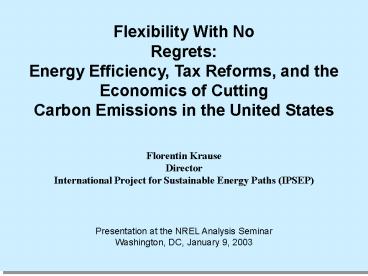Flexibility With No - PowerPoint PPT Presentation
1 / 23
Title:
Flexibility With No
Description:
Flexibility With No. Regrets: Energy Efficiency, Tax Reforms, and the ... International Project for Sustainable ... The mounting scientific evidence ... – PowerPoint PPT presentation
Number of Views:38
Avg rating:3.0/5.0
Title: Flexibility With No
1
Flexibility With No Regrets Energy
Efficiency, Tax Reforms, and the Economics of
Cutting Carbon Emissions in the United
States Florentin Krause DirectorInternational
Project for Sustainable Energy Paths
(IPSEP) Presentation at the NREL Analysis
Seminar Washington, DC, January 9, 2003
2
Research Co-authors
Stephen J. DeCanioDepartment of Economics,
University of California, Santa Barbara
J. Andrew HoernerCenter for a Sustainable
Economy, Washington, DC
Paul BaerEnergy and Resources Group,
University of California, Berkeley
Published in Contemporary Economic Policy,
Vol. 20, No. 4, October 2002, 339-365
3
Before we begin.
- Economic analysis does not and cannot provide
- all the answers on climate policy
- The distribution of costs, benefits, and
consequences - across generations and world regions can
only be - addressed properly in a moral/ethical
framework
- The mounting scientific evidence of
anthropogenic - climate change implies that a policy
response will - be necessary orderly and moderate
measures are - preferable to a crisis response
- Climate policy offers a remarkable opportunity
for - bipartisan consensus
4
Policies Available to Reach Kyoto Target at Least
Cost
- Carbon tax or permit auctions
- Revenue recycling to reduce tax distortions
- Institutional and market reforms
- Enhanced RD
- International permit trading
- Credits for carbon sinks
5
None of the Studies Relied on by the United
States Government Included All Major Policy
Options
- EIA (1998), EMF-16 (1999), CEA (1998), IWG (1997)
IWG-CEF (2000) - All the studies modeled a carbon price
- None of the studies measured co-benefits
- Only IWG and CEF incorporated market reforms
- Only IPSEP (2001) analyzed an integrated approach
encompassing all policies, including tax shifting
6
Policy Analysis Gaps...
7
Incomplete system boundaries...
8
Conventional Wisdom A Tradeoff
between Economic Output and Emissions Reductions
GDP
GDP0
GDP1
Carbon Charge
GDP0 - GDP1 Substitution Effect
Emissions Reductions
9
Reality A Band of Possibility that
Describes What the Economy Can Accomplish
GDP
Efficiency Enhancements, RD
GDP2
BAU
GDP0
Band of Economic Possibilities
Tax Reform
GDP1
Carbon Charge
Smart policies can increase GDP and reduce
emissions GDP2 gt GDP0
Emissions Reductions
10
(No Transcript)
11
(No Transcript)
12
(No Transcript)
13
(No Transcript)
14
(No Transcript)
15
Distribution of U.S. jobs in 1995 (Total 132
million)
16
Impact of CEF scenario plus payroll tax rebate on
prices of U.S. exports (50/tC)
17
Energy sector impacts of alternative U.S. climate
policy strategies in 2010
18
Until very recently, Chinas greenhouse gas
emissions were growing rapidly
Carbon Emissions by Country, 1980-1997
19
But energycoalconsumption began to fall after
1996
Coal Use by Sector, 1980-1998, and Projections
20
Change in Chinas emissions outlook recognized
since 2001 in EIAs International Energy Outlook
21
Projections of carbon emissions may need to be
revised further downwards
22
National and Global Equity Factors (income of
poorest segment rel. to average income)
23
Conclusions
- Inadequate economic analysis contributed to the
U.S. Kyoto policy debacle - International trading, sinks, supplementarity
should not have been deal-breakers - Domestic actions are the key to least-cost
emissions reductions efficiency improvements
and tax shifting - Almost all U.S. industries would benefit, and
workers in losing sectors could be compensated. - Early caps on emissions of developing countries
are unnecessary and would be unfair































